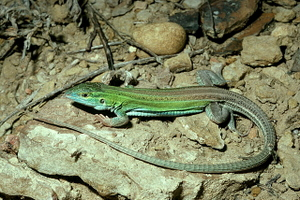Six-lined racerunners, like other whiptails, are indeed fast afoot. They have been clocked running at 18 miles (29 kilometers) per hour, though their sprints are generally short.
Photo Credit: Geoffrey A. Hammerson
Aspidoscelis sexlineatus
Common Name: six-lined racerunner
Other Common Names: huico de seis líneas
Other Scientific Names: Aspidoscelis sexlineata, Cnemidophorus sexlineatus
Animal Guild: Reptile
Class > Order > Family: Reptilia > Squamata > Teiidae
What does the species look like?
These lizards have a long and slender body, small granular scales on the back, and larger rectangular scales on the belly. Three pale stripes extend along each side of the back, and there is a middorsal stripe that sometimes is divided into two stripes. There are no light spots or bars in the dark fields between the stripes. In some regions, the neck and shoulders of adults often have a bright greenish wash. The scales on the undersurface of the base of the forelimb are not enlarged. Maximum size is about 10.5 inches (27 cm) in total length, 3.5 inches (8.8 cm) snout-vent length. Mature males have a pale blue belly (whitish in females). Hatchlings are 1.2-1.4 inches (31-35 mm) in snout-vent length, with a bright blue tail and light stripes that contrast sharply with the dark areas on the shoulders. In general, racerunners are much less shiny than skinks, some of which often have similar striping and color patterns.
Where is the species found?
States & Provinces
AL, AR, CO, FL, GA, IA, IL, IN, KS, KY, LA, MD, MI, MN, MO, MS, NC, NE, NM, OK, SC, SD, TN, TX, VA, WI, WV, WY
Distribution
Range extends from eastern Wyoming, South Dakota, Minnesota, Wisconsin, Indiana, Kentucky, Virginia, and Maryland south to southern Texas, the Gulf Coast, and southern Florida.
Six-lined racerunners inhabit grassland, sandhills, scrub, sandy or gravelly banks and floodplains of streams, sparsely vegetated rocky areas at the base of mountains, woodland edges and open woods, beach dunes, and similar situations with full or partial sun exposure.
General Phenology and Life History
Racerunners are active only during warm daylight hours but generally seek shelter during the hottest midday period in summer. Activity occurs from May-September in the north and over a somewhat longer period in areas to the south. Those active in late summer and fall are mostly hatchlings. In Georgia and Alabama, juveniles emerge as early as mid-March, adults mid-April to early May. During inactive periods, these lizards shelter underground or under rocks or other objects on the ground. In most areas, courtship and mating occur in late spring or early summer. Reproductive females deposit 1-3 clutches of 1-6 eggs during May-August; in the north, egg laying does not begin until June. Eggs are laid in nests dug in soft soil or sawdust piles or under logs or other sheltering objects. Eggs hatch in about 2 months, mostly late July (August in the north) to September.
Which phenophases should I observe?
Do you see/hear...?
Activity
Individuals on land More...
For abundance, enter the number of individual animals observed in this phenophase.
Feeding For abundance, enter the number of individual animals observed in this phenophase.
Development
Young individuals For abundance, enter the number of individual animals observed in this phenophase.
Dead individuals For abundance, enter the number of individual animals observed in this phenophase.
What do these phenophases look like?
There is currently no photoguide available for this species. If you'd like help us create one, use the guidance document and species template provided here . Then send it via email to education@usanpn.org when it is complete.
